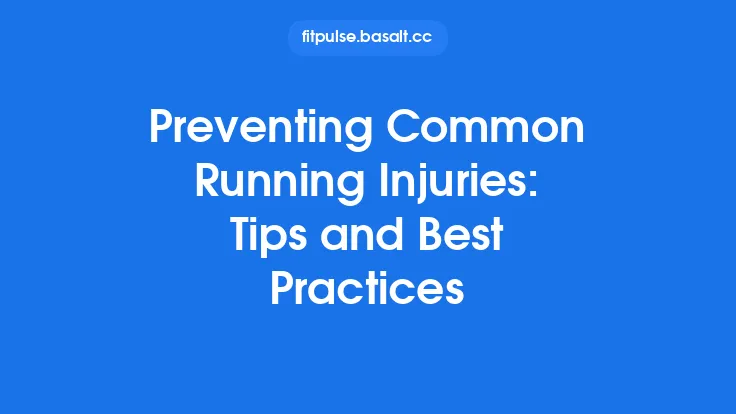Running is one of the most natural movements we perform, yet the way we move through each stride can dramatically affect speed, efficiency, and long‑term joint health. By mastering the fundamentals of running form, you can conserve energy, reduce the risk of overuse injuries, and lay a solid foundation for every type of training—from easy jogs to race‑day efforts. This guide breaks down the key components of an efficient stride, explains why they matter, and offers practical drills and cues you can incorporate into any training routine.
Understanding the Biomechanics of Running
Running is a cyclical process that alternates between a support phase (when one foot is on the ground) and a flight phase (when both feet are airborne). During the support phase, the body must absorb impact, store elastic energy, and generate forward propulsion. The flight phase allows that stored energy to be released, contributing to stride length and speed. Efficient runners minimize unnecessary vertical oscillation, keep the center of mass moving forward, and coordinate the lower‑body joints (ankle, knee, hip) in a smooth, spring‑like motion.
Key biomechanical concepts:
- Ground Reaction Force (GRF): The force exerted by the ground on the foot. A well‑timed GRF curve peaks early in the stance, indicating effective use of the leg’s elastic structures.
- Leg Stiffness: The ability of the leg to resist deformation under load. Optimal stiffness balances shock absorption with energy return.
- Stride Frequency vs. Stride Length: These two variables are inversely related; increasing cadence (steps per minute) typically shortens stride length, while a longer stride can reduce cadence. The most economical combination varies by individual but generally falls between 170–190 steps per minute for most recreational runners.
Posture and Alignment
A neutral, forward‑leaning posture sets the stage for efficient force transmission. Think of the body as a single, aligned column:
- Head and Gaze: Keep the chin slightly tucked and eyes focused about 10–20 meters ahead. This encourages a natural forward tilt without excessive neck tension.
- Shoulders: Relax the shoulders, allowing them to stay level and slightly behind the hips. Avoid hunching or excessive elevation, which can waste energy and restrict arm swing.
- Spine: Maintain a slight lumbar curve (neutral spine) while allowing a gentle forward lean from the ankles, not the waist. This leverages gravity to aid forward propulsion.
- Pelvis: The pelvis should remain stable, with minimal anterior or posterior tilt. Excessive tilt can alter hip joint angles, leading to over‑pronation or excessive knee flexion.
Foot Strike and Ground Contact
The point of contact between foot and ground influences shock absorption and propulsion. While individual anatomy dictates some variation, the following principles apply broadly:
- Midfoot or Forefoot Preference: Landing with the midfoot or forefoot allows the ankle’s spring‑like structures (Achilles tendon and calf muscles) to store and release elastic energy. A heavy heel strike often results in a braking force that slows forward momentum.
- Quiet Footfall: Aim for a light, “quiet” foot strike. Excessive impact noise indicates a hard landing, which can increase stress on the tibia and joints.
- Foot Placement Relative to Center of Mass: The foot should land roughly beneath the body’s center of mass, not far ahead. Overstriding (landing with the foot too far in front) creates a braking effect and increases the load on the knee joint.
Cadence and Stride Length
Cadence—measured in steps per minute (spm)—is a powerful lever for improving efficiency and reducing injury risk. Research consistently shows that increasing cadence by 5–10 % can lower peak joint forces without compromising speed.
How to Find Your Optimal Cadence:
- Baseline Measurement: Use a GPS watch or metronome app to record your natural cadence during an easy run.
- Incremental Adjustment: Increase the cadence by 5 % and maintain it for a few minutes, focusing on shorter, quicker steps.
- Feedback Loop: Pay attention to how your knees, hips, and calves feel. If you experience excessive calf fatigue, you may be transitioning too quickly to a forefoot‑dominant pattern; adjust gradually.
Remember, cadence and stride length are interdependent. A higher cadence naturally shortens stride length, which reduces the likelihood of overstriding and the associated braking forces.
Arm Swing and Upper Body Mechanics
The arms act as a counterbalance to the legs, helping to stabilize the torso and contribute to forward momentum. Effective arm mechanics include:
- Elbow Angle: Keep elbows bent at roughly 90 degrees. This allows a compact swing that does not waste energy.
- Swing Path: Move the arms forward and backward in a straight line, avoiding excessive cross‑body motion. The hands should travel from about chest height in front of the body to just past the hips behind.
- Relaxed Hands: Lightly cup the hands, avoiding clenched fists. Tension in the upper body propagates down the kinetic chain, increasing overall fatigue.
Core Stability and Pelvic Control
A strong, engaged core stabilizes the pelvis and spine, preventing excessive rotation and lateral wobble that can lead to inefficient stride patterns and injury.
- Isometric Core Activation: Prior to each stride, gently engage the deep abdominal muscles (transversus abdominis) without sucking in the belly. This creates a firm “corset” around the lumbar spine.
- Hip Hinge Awareness: Practice a slight posterior pelvic tilt during the stance phase to maintain a neutral spine and reduce lumbar extension stress.
- Dynamic Core Drills: Incorporate planks, side planks, and anti‑rotation exercises (e.g., Pallof press) into your strength routine to reinforce the stabilizing role of the core during running.
Common Form Errors and How to Fix Them
| Error | Typical Cause | Correction Cue |
|---|---|---|
| Overstriding (foot lands far ahead) | Trying to increase speed by lengthening stride; low cadence. | “Land under your hips.” Use a metronome to raise cadence by 5 %. |
| Excessive Heel Strike | Habitual shoe cushioning; weak calf muscles. | “Think of landing on the middle of your foot.” Add short, quick strides on grass or a treadmill. |
| Excessive Vertical Oscillation | Over‑reliance on leg power; lack of forward lean. | “Keep your torso slightly tilted forward from the ankles.” Practice running on a slight incline. |
| Cross‑Body Arm Swing | Tension in shoulders; lack of core stability. | “Keep elbows close to the body, swing straight forward and back.” Perform arm swing drills without legs. |
| Hip Drop (Trendelenburg) | Weak gluteus medius; poor pelvic control. | “Squeeze your glutes as the opposite leg lifts.” Add single‑leg bridges and side‑lying clamshells. |
| Excessive Torso Rotation | Trying to “twist” for speed; weak core. | “Imagine a straight line from head to hips.” Perform running drills with a towel held across the shoulders to limit rotation. |
Drills and Exercises to Reinforce Good Form
- High‑Knee Skips: Emphasize quick, light foot contacts while driving the knees up. Enhances cadence and midfoot landing.
- Butt Kicks: Promote a rapid leg turnover and reinforce a slight forward lean.
- A‑Skip and B‑Skip: Combine knee lift with a quick, snapping foot motion, teaching proper foot placement and arm swing coordination.
- Strides (80‑90 % effort, 20‑30 m): Focus on smooth, relaxed form; use these as “form rehearsals” before harder workouts.
- Hill Repeats (moderate gradient, 30‑60 s): Naturally encourage a midfoot strike and higher cadence while strengthening calves and glutes.
- Core Circuit (Plank variations, Pallof press, dead‑bugs): Perform 2–3 sets 2–3 times per week to maintain pelvic stability.
Integrating Form Work into Your Training
- Warm‑Up Phase (10‑15 min): Begin with easy jogging, then transition into dynamic drills (high‑knees, butt kicks, A‑skips). This primes the neuromuscular system for proper mechanics.
- Dedicated Form Sessions (once per week): Allocate 20–30 minutes to focused drills, stride analysis, and short strides. Treat these as skill‑practice days, not speed or endurance days.
- During Regular Runs: Periodically check in with yourself every 5–10 minutes. Ask: “Am I landing under my hips? Is my cadence high enough? Are my shoulders relaxed?” Small self‑checks reinforce habit formation.
- Cool‑Down (5‑10 min): Finish with easy jogging and static stretching for the calves, hamstrings, and hip flexors to maintain flexibility and aid recovery.
Monitoring Progress and Using Feedback Tools
- Metronome Apps: Set a target cadence (e.g., 180 spm) and let the beat guide your steps. Many runners find a subtle “click” in the ear helps maintain rhythm.
- Video Analysis: Record a 30‑second segment of your run from the side and front. Look for foot placement, knee lift, and arm swing symmetry. Slow‑motion playback can reveal hidden inefficiencies.
- Wearable Sensors: Some GPS watches and foot pods provide real‑time cadence, ground contact time, and vertical oscillation data. Use these metrics to track improvements over weeks.
- Perceived Effort Scale: After a run, rate how “easy” the stride felt on a 1–10 scale. A lower rating at the same pace indicates improved efficiency.
Building a Sustainable Form‑First Mindset
Mastering running form is not a one‑time event but an ongoing process of awareness, feedback, and incremental adjustment. By treating each run as an opportunity to refine technique—rather than solely a vehicle for mileage or speed—you create a resilient foundation that supports long‑term performance and health. Remember:
- Consistency Beats Intensity: Small, daily form cues accumulate into major biomechanical gains.
- Patience Is Key: Neuromuscular adaptations can take 4–6 weeks to become automatic.
- Listen to Your Body: If a new cue causes pain (e.g., sudden forefoot loading leading to calf strain), back off slightly and progress more gradually.
With diligent practice, the efficient stride you develop will translate into smoother runs, faster times, and fewer days sidelined by injury. Embrace the mechanics, stay curious, and let each step move you closer to your best running self.





